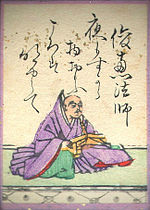(1717 AD), when Shinroku Yamamoto, who had worked as a gatekeeper at Chōmei-ji Temple since 1691, established a teahouse named Yamamoto-ya in front of...
6 KB (527 words) - 15:06, 16 April 2024
Korea and at Japanese Buddhist temples around the world. Bell ringing at Chomei-ji in Shiga Problems playing this file? See media help. The custom of ringing...
12 KB (1,562 words) - 11:36, 9 October 2024
136°08′36″E / 35.421122°N 136.143225°E / 35.421122; 136.143225 (Hōgon-ji) 31 Chōmei-ji Senju Kannon Jūichimen Kannon Shō Kannon Ōmihachiman Shiga 35°09′46″N...
11 KB (291 words) - 06:35, 8 August 2024
Chōmei-ji, 31st temple of the Saigoku Kannon Pilgrimage (西国三十三箇所, Saigoku sanjūsankasho) Kannonji Castle ruins, National Historic Site Kannonshō-ji,...
10 KB (910 words) - 22:58, 5 October 2024
Reigan-ji Shōon-ji Ryūsen-ji Chōnen-ji Fukutoku-ji Hōkō-ji Tenryū-ji Hachiō-ji Chōmei-ji Dōjō-ji Sanpō-ji Nyoirin-ji Tamon-ji Zenryū-ji Tokuzō-ji Enjō-in The...
22 KB (715 words) - 07:44, 13 October 2024
influences are inclusive in Chōmei's work. Chōmei understands Buddha's ideology of not becoming attached to material things, but Chōmei believes is that what...
26 KB (3,742 words) - 03:24, 21 October 2024
one of the Three Views of Japan. Nearby cultural properties include Zuigan-ji, Entsū-in, Kanrantei, and the Satohama shell mound. A well-known haiku describes...
7 KB (565 words) - 20:58, 5 August 2024
Lakeshore Village (ja) Traditional Methods of Fishing Ōmihachiman Chōmei-ji (ja); Isaki-ji (ja) Traditional Regional Dishes Waterways of Ōmi-Hachiman (ja)...
132 KB (171 words) - 18:28, 14 October 2024
to be in keeping with Japan's wabi-sabi aesthetic. Chomei-ji no Bonshō Sound of the bell in Chomei Temple, Ōmihachiman Problems playing this file? See...
29 KB (3,193 words) - 15:58, 25 September 2024
鳥居清長筆 ita-e chakushoku yakusha-e Torii Kiyonaga hitsu Edo period Nerima Chōmei-ji (長命寺) 121 centimetres (48 in) by 136 centimetres (54 in) 35°44′38″N 139°36′52″E...
56 KB (281 words) - 17:31, 29 August 2024
(1118–1190) Minamoto no Sanetomo (1192–1219) Emperor Go-Toba (1180–1239) Kamo no Chōmei (1155–1216) Motoori Norinaga (1730–1801) Ueda Akinari (1734–1809) Ryōkan...
22 KB (2,544 words) - 19:33, 7 February 2024
District, Gifu Kamo District, Hiroshima Kamo District, Shizuoka Kamo no Chōmei Kamo Shrine Kamo, Kyoto Kamo, Niigata Kamo, Okayama Kamo, Shimane Kamo,...
19 KB (1,835 words) - 20:17, 17 March 2024
abbot of Eigen-ji, which was constructed solely for him to teach Zen Jien 慈円 (1155–1225) poet, historian, and Buddhist monk Kamo no Chōmei 鴨長明 (1155–1216)...
11 KB (1,213 words) - 23:06, 22 October 2024
Classical Thirty-Six Immortals of Poetry. He was a poetic mentor to Kamo no Chōmei. The following poem by him was included as No. 85 in Fujiwara no Teika's...
5 KB (350 words) - 12:10, 19 October 2023
the team of editors. Other editors included Fujiwara no Teika and Kamo no Chōmei. The Kamakura period influence continued after the end of the actual period:...
49 KB (6,798 words) - 13:23, 22 August 2024
spiritual practice that leads to enlightenment, as the Japanese monk poet Chōmei writes in his Hosshinshū. Zen paintings are sometimes termed zenga in Japanese...
197 KB (22,966 words) - 05:38, 28 October 2024
p. 783. Titsingh, p. 198. Titsingh, p. 199. Kitagawa, p. 784. Kamo no Chōmei. (1212). Hōjōki. Brown, p. 331. Brown, p. 332. Titsingh, p. 195; Brown,...
13 KB (1,241 words) - 16:56, 24 September 2024
Takakura tennō shinkan goshōsoku a letter by emperor takakura 1178 - Seigan-ji urabon engi a history of the ghost festival scroll 1180 - Takakura-in Itsukushima...
32 KB (3,062 words) - 05:17, 23 July 2024
Gukanshō. Essays called zuihitsu came to prominence with Hōjōki by Kamo no Chōmei and Tsurezuregusa by Kenkō. Japanese Buddhism also underwent a reform during...
75 KB (8,733 words) - 00:09, 28 March 2024
"itsukushimi" Haibutsu kishaku Hakkō ichiu Hermit – e.g., Yoshida Kenkō, Kamono Chōmei Kami Kokutai Ma (negative space) Maruyama Masao – "Bamboo whisk" culture...
27 KB (3,526 words) - 06:04, 23 July 2024
Kambara Hayao (1876–1952), Taishō- and Shōwa-period poet and novelist Kamo no Chōmei 鴨長明 (1155–1216), author, waka poet and essayist Kamo no Mabuchi 賀茂真淵 (1697–1769)...
52 KB (6,040 words) - 13:21, 7 August 2024
the most famous poets who wrote shakkyōka are: Saigyō; Jakuren; Kamo no Chōmei; Fujiwara no Shunzei; Jien; Nōin; Dōgen, Ton'a, etc. Many of the so-called...
40 KB (4,744 words) - 16:31, 14 January 2024












